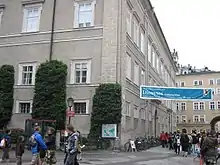Dionysos (opera)
Dionysos is an opera by Wolfgang Rihm based on Friedrich Nietzsche's Dionysian-Dithyrambs. The composer wrote the libretto and subtitled his work: "Opernphantasie nach Texten von Friedrich Nietzsche / Szenen und Dithyramben" ("Operatic fantasy after texts by Friedrich Nietzsche / Scenes and dithyrambs). It premiered at the Salzburg Festival on 27 July 2010.
| Dionysos | |
|---|---|
| Opera by Wolfgang Rihm | |
 Entrance to the premiere of the Salzburg Festival 2010 | |
| Language | German |
| Based on | Dionysian-Dithyrambs by Friedrich Nietzsche |
| Premiere | |
History
Dionysos is Rihm's eleventh work for the stage. He considered an opera around Dionysos for 15 years[1] and realized it when he received a commission from the Salzburg Festival, the Staatsoper Unter den Linden Berlin and De Nederlandse Opera. Rihm wrote the libretto, based on Nietzsche's late work, which he fragmented and arranged in a different order. He chose the passages according to his plans for the music.[2] Rihm said in an interview that opera needed more Magic Flute, "Mehr Machwerk." (More action.), citing the opening scene with three ladies coming to the rescue of the prince attacked by a snake. Rihm said that opera finds its potential in situations that are not ordinary ("... findet ihre Möglichkeiten in Situationen, die nicht alltäglich sind").[2] The opera has autobiographical traits and is in a way his first comic opera.[2]
Rihm dedicated the work "in friendship" to the conductor Ingo Metzmacher.[3] Rihm composed mostly between December 2009 and May 2010, sending it in batches to the conductor.[1] He finished the finale last minute.[2]
The opera premiered at the Haus für Mozart in Salzburg on 27 Juli 2010. Johannes Martin Kränzle performed the title role (N.), with Mojca Erdmann, Elin Rombo and Matthias Klink in leading roles, the Deutsches Symphonie-Orchester Berlin and the Vienna State Opera Chorus, conducted by Metzmacher and staged by Pierre Audi.[4][5][6] The magazine Opernwelt chose the performance as the premiere of the year (Uraufführung des Jahres), and Kränzle as singer of the year.[2][7] A live recording was published as DVD.
The production was repeated from 8 June 2011 in Amsterdam and from 8 July 2012 in Berlin. A new production was staged on 8 February 2013 at the Theater Heidelberg by Ingo Kerkhof.[8]
Plot
The main character is called N., a symbol for both the poet Nietzsche, but also for Dionysos whose name Nietzsche used as his pen name for the dithyrambs. Some scenes relate to events in Nietzsche's life, others with the Dionysos myth.[3] The action is not a linear story, but shows different views on life (Lebensbilder).[6]
Music
A review of the premiere in Opernwelt notes the overwhelming echos of late-romantic sensuality of sound (überbordender "Nachhall spätromantischer Klangsinnlichkeit"), reminiscent of Richard Strauss and Johannes Brahms.[1][4]
Literature
- Ivanka Stoianova: Wolfgang Rihm – Dionysos: a writing on inner spaces in: Art Research Journal V. 2, n. 1, Januar/Juni 2015, p.36–52
References
- Lange, Joachim (28 July 2010). "Bergwandern mit Nietzsche". Opernwelt.
- Büning, Eleonore (2011). "Uraufführung des Jahres – Mehr Machwerk, bitte!". Opernwelt Jahrbuch 2011: 28. Retrieved 19 August 2016.
- "Dyonisos". Universal Edition. Retrieved 19 August 2016.
- Tommasini, Anthony. "A Nietzschean Plunge Into Sensual Labyrinths". The New York Times.
- Büning, Eleonore (29 July 2010). "Ich bin dein La-La-La-Labyrinth". Frankfurter Allgemeine Zeitung (in German). Frankfurt. Retrieved 2 September 2017.
- "Dyonisos". Salzburg Festival. Archived from the original on 19 August 2016. Retrieved 19 August 2016.
- "Das Herz der Opernwelt schlägt nun in Brüssel". Badische Zeitung (in German). Freiburg. 29 October 2011. Retrieved 2 September 2017.
- "Ingo Kerkhof". Theaterundorchesterheidelberg. Retrieved 29 September 2017.
External links
| Wikimedia Commons has media related to Dionysos (Rihm). |
- Claus Spahn: So schnell schluckt uns die Tiefe! (review) Die Zeit, 5 August 2010
- Roberto Becker: Aus der schönen alten Welt. (review) Online Musik Magazin
- Joachim Lange: Musik als Ausbruch. (review) Online Musik Magazin 2013